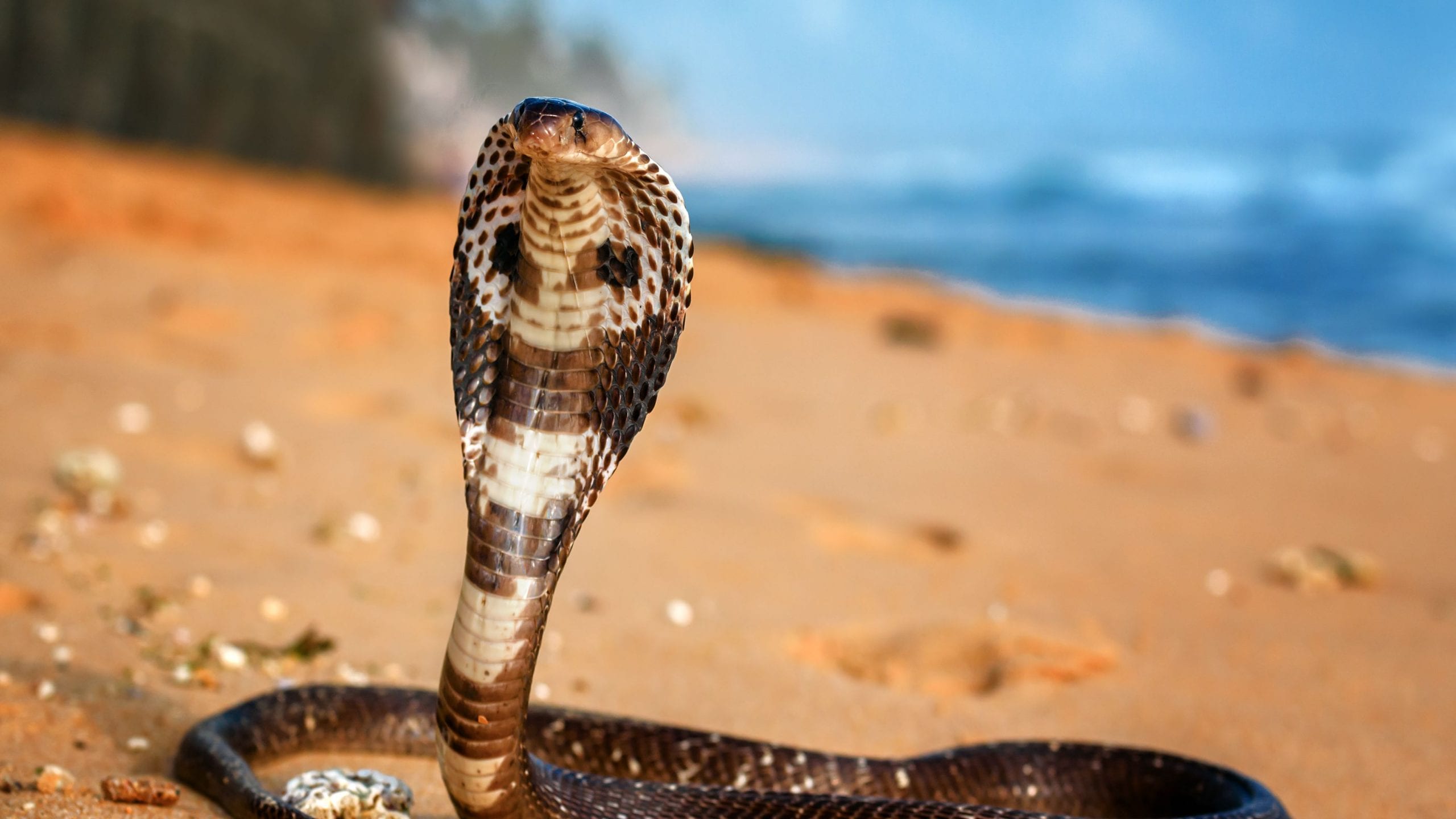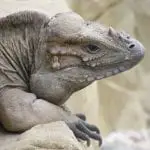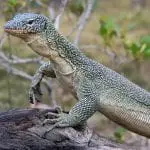Scientific Facts
| Common Name | King Cobra, hamadryad |
| Scientific Name | Ophiophagus hannah |
| Captive Lifespan | 12 to 20 years |
| Size | Adults: 3.18 to 4 m (10.4 to 13.1 ft) |
| Mass | about 6 kg (13 lb) |
| Habitat | dense highland forests (preferably areas spotted with streams and lakes) |
| Country of origin | India, South Asia |
Physical Description
The average size of a King Cobra is 10-12 feet. However, although occasionally, it can reach 18.5 feet (5.7 meters). Known as the largest of all venomous land snakes, a King Cobra’s width at the neck is of up to 1 foot (0.3 meters). Being slender in general, a King Cobra’s weight would typically reach no more than 44 pounds (20 kilograms).
When full-grown, a King Cobra is to be colored in brown, black, green, or yellow. Despite their scaly skin possessing a distinct glisten, it is actually fairly dry to the touch.
Usually, King Cobras have whitish or yellowish chevrons or crossbars on their bodies, and their throats vary in color, ranging from light yellow to creamy, beige-colored nuances. The King Cobra’s belly may be ornamented with bars, or it may be uniform in a single color.
Juvenile King Cobras are smaller in size than adults, and they are shiny, jet-black, with their bodies and tails having white or yellow-cross bars. Also, there are four similar cross-bars located on their heads.
The major feature distinguishing the king cobra from any other cobras is the availability of 11 large scales located on the very crown of the head. Female King Cobras have a total of 239 – 265 ventral scales, while male King Cobras have 235 to 250 ventral scales.
Types
Interestingly, there is a bit of confusion as to what a cobra actually is. Even though the King Cobra is undoubtedly the most famous type of cobra, to all intents and purposes, it belongs to its own genus Ophiophagus, while true types of cobras belong to another genus, namely Naja.
There are 270 different species of cobras out there. However, if we are to only count the member of the Naja genus, the actual number of cobra species on a global scale is to be reduced to a total of 31 (for instance, coral and shield cobras do also not belong to the genus Naja but to the genus Aspidelaps).
The number of true cobras that spit venom make up for about ten species, examples of which include the giant spitting cobra, native to Africa (N. Ashia), and the Mozambique spitting cobra (N. Mossambica).
Quite often, cobras are named after the country in which they are found or their preferred habitat. For instance, the forest cobra (N. Melanoleuca) is a cobra that lives West Africa’s forests. Cape cobra (N.nivea), can be found in the Cape area of South Africa, while the Indian cobra (N.naja) is known to inhabit the Indian subcontinent.
Other cobras that are named after the region they inhabit include but are not limited to the Philippine cobra (N. philippinesis), and the Chinese cobra (N. atra).
Habitat & Lifespan
King cobras are distributed across Southeast Asia and the Indian subcontinent, from Northern India, and all the way to southern People’s Republic of China, (Hainan and Hong Kong included), and throughout the Malay Peninsula, to the Philippines and western Indonesia. Although less commonly found there, King Cobras are also known to inhabit areas of East Asia.
King cobras can be found near streams, in bamboo thickets, as well as in open or dense forests. They can also be spotted in dense mangrove swamps and in adjacent agricultural areas.
The average lifespan of King Cobras kept in captivity is 17.1 years, ranging from 12 to 20 years. With wild King Cobras, the average lifespan remains the same as with domesticated King Cobras – about 20 years.
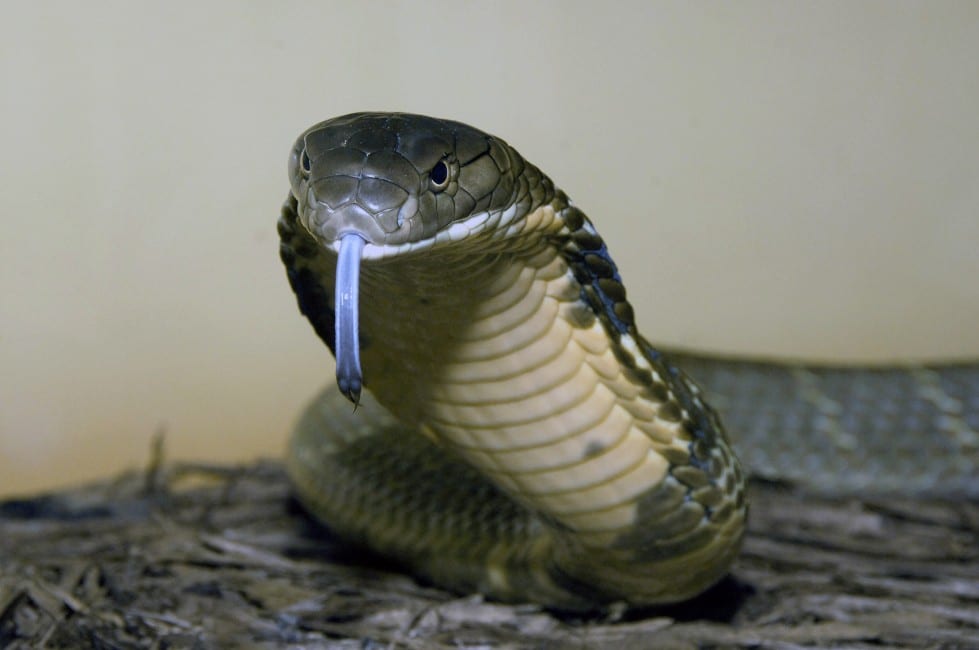
Caging
When kept as pets, King Cobras should be best given their very own enclosures. As a rule of thumb, a max of one pair per enclosure is the way to go. King Cobras are to be only housed together during attempts for breeding.
Enclosures must be at least 5 feet in width and 10 feet in length. Mind that the enclosure’s proper dimension is to ensure that a person would be able to freely stand, as well as a maneuver, during maintenance practices.
Large enclosures are highly recommendable for King Cobras, such as, for instance, a 16 x 7 x 7 feet (4.9 x 2.1 x 2.1 meter) enclosure.
Although King Cobras typically refuse to be goaded into entering a box, having at least one switch box (or lockable hide box), is crucially important.
It tends to be challenging to remove an adult Cobra snake from its enclosure when necessary, so choosing a properly designed cage is crucial.
Mind that when a King Cobra is provided a larger enclosure, it becomes a different animal than if placed in a small cage, when speaking in terms of behavior. A large cage will allow owners to admire the true magnificence and intelligence of King Cobra, as the snake is to literally make use of every inch of the cage, having lots of territories to roam.
Climbing opportunities are essential, too. King Cobras love to spend quite some time in the trees in the wild, so climbing opportunities are sure to please captivated specimens. Vining plants, such as Pothos attached to the cage’s walls and cascading downwards across the substrate, can be a fantastic choice.
Behavior
King cobras are impressively intelligent creatures, and their behavior is no less impressive. Their temper is both timid and brave, and everything in between. A King Cobra kept as a pet can be just as easy to handle as it can be difficult, too.
Because of Ophiophagus Hannah’s intelligence, keepers can develop a very strong relationship with this unique type of snake, and this relationship is to only be maximized and made as enjoyable as possible by making sure to provide the best living environment, and by further keeping high hygiene standards and feeding practices strictly and dedicatedly.
Unless it is cornered or provoked, a King Cobra would always prefer to escape, rather than to attack, despite bearing the fearsome reputation as one of the most dangerous snakes out there due to its fatally potent venom.
However, for nesting female King Cobras, attacking without any provocation is quite possible.
Whenever faced with a threat, a King Cobra can raise the body’s anterior part about one meter off the ground. Once it does so, it is fully capable of following the enemy in this particular, peculiar position over some very considerable distances.
Substrate
In general, the substrate can be broken down into two major categories. The first one is substrate tailored for bioactive enclosures, and the second is everything else.
If a keeper is to opt for an absorbent, loose, non-compacting type of substrate that can be easily replaced and is also quite low-cost, then he/she must note that such type of substrate is appropriate for all, with one main exception: bioactive cages.
Non-treated mulch, moss, shredded aspen, as well as many of the commercially available bedding products, can work fine as an appropriate substrate for King Cobras.
As a rule of thumb, the substrate has to be deep enough to allow the snake to conceal if it is to decide to burrow.
Commercial cage lines and newspapers can do the trick, too, however, since King Cobras tend to frequently produce a big amount of liquid waste, these are not the best substrate options out there.
Absorbable bedding is capable of containing the mess until cleaned. Furthermore, it prevents the King Cobra from getting covered in feces while crawling through soggy newspaper. During quarantine periods or mites attacks, absorbable bedding is not an option, though.
In very large cages, setting up bioactive substrates that can absorb most of the wastes without frequent cleansing services, is fully possible. You can also make the best use of free-ranging Anole species in order to naturally take care of any flies that often tend to reproduce in the substrate.
For large, walk-in-type of enclosures, the bioactive substrate can be as deep as 18 inches (45.7 cm). The first layer can be made out of rocks the size of a chicken egg.
Next, a sheet of greenhouse ground fabric (water permeable) can be utilized, followed up by a layer of pea gravel (about 3 inches deep in this particular example).
Upon the layer of pea gravel, a layer of fertilizer-free, organic garden soil that is further mixed with fine grade perlite and vermiculite to ensure proper drainage is to be set and topped with a hardwood mulch layer.
Since hardwood mulch does not absorb water, and it also dries fairly quickly, it is especially important during the “wet season.” Although there is no real “wet season” in captivated King Cobra’s cages, you can mimic this by raining on the cages for 1 hour per session, 4 times a day.
Starter cultures of isopods and springtails and isopods can be also added to bioactive substrates in order to aid in breaking down the waste.
If one is to utilize deep layers of substrate, even a very large King Cobra will burrow at times.
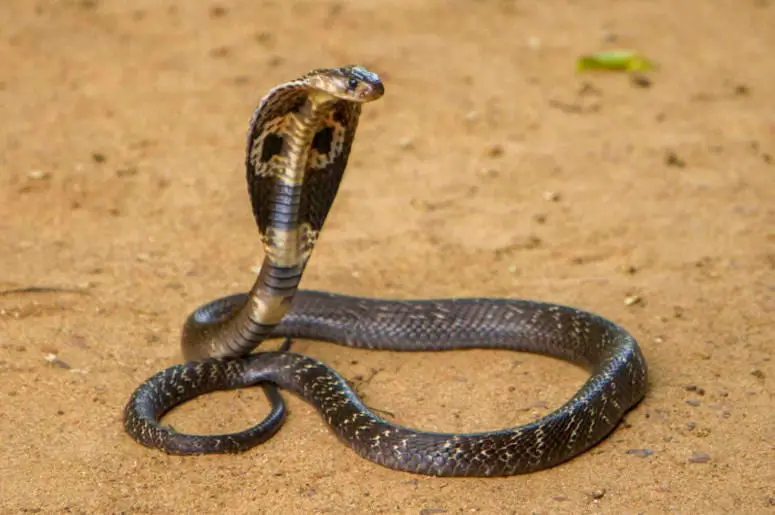
Temperature, Lighting, and Humidity
It is debatable (either way) whether light bulbs that mimic natural sunlight are the best choice for proper and successful maintenance. Both “soft white” and “daylight” fluorescent tubes can work for providing the much-needed access to light for King Cobras kept in captivity.
Basking lights must be provided to gravid female King Cobras.
Depending on the season, the most favorable temperature rates for King Cobras can vary but majorly fall into the average range of 82F – 88F (27.7C – 31.1C).
Spraying the nursery with clean water can help King Cobra keepers to increase humidity, as well as to mimic seasonal changes, water the plants (if any), and to stimulate breeding. An advanced option is to use programmable rain systems, with floor drains to ensure that excess water can easily escape.
Full automation will allow King Cobra keepers to enjoy more time with these majestic creatures, by spending less time cleaning the cage.
Keep humidity rates above 70% to ensure the health and well-being of King Cobras.
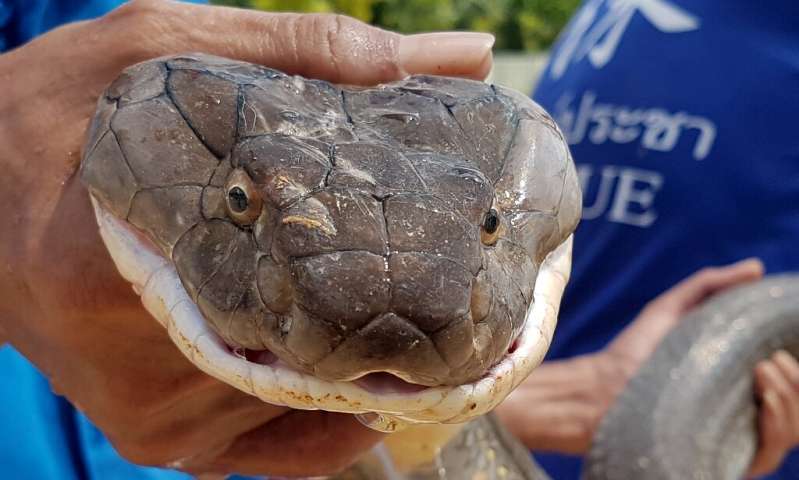
Diet
In the wild, the King Cobra snake is known to follow an ophiogaphy diet, which is a specialized form of alimentary or feeding behavior of particular animals hunting and eating snakes. In a nutshell, the diet of a King Cobra mainly consists of other snakes.
Typically, in their natural habitat, King Cobras prefer to snack on non-venomous snakes. However, on certain occasions, they can also eat other venomous snakes, including but not limited to Indian Cobras and kraits.
When food is scarce, small vertebrates, such as lizards, can also turn into potential prey for King Cobras.
Eating Habits
King Cobras swallow their prey whole, starting with the head first. A King Cobra cannot chew its prey but instead, it makes use of its top and bottom jaws, which are attached with stretchy ligaments to each other, allowing the snake to swallow animals that are much wider than itself.
In the snake’s stomach, food is successfully digested thanks to very strong acids. Due to their very slow metabolic rates, King Cobras can live for months without taking another meal after having a significantly large meal.
King Cobras, similarly to other snakes, use their forked tongue to catch smells, picking up scent particles and then transferring these to their Jacobson’s organ, which is a specific sensory receptor that is located at the mouth’s roof.
As soon as the scent of potential prey is detected, the King Cobra’s tongue is to continue to flick, gauging the meal’s direction. King Cobras also have excellent eyesight, using it to detect moving prey almost 100 meters (300 feet) away, thanks to sensitivity vibrations, and nonetheless, thanks to King Cobras’ outstanding prey-track intelligence.
King Cobras kept in captivity do often tend to refuse to eat, provided they have been collected from the wild.
Usually, King Cobra pets are to take several rabbits and/or large rats a week, and any snakes are more than welcome meals, too. A large King Cobra male may eat over 5 pounds of snakes and rats within a single week but would then typically take a rest from large meals for an extended period of time.
Sleeping Habits
King Cobras are diurnal creatures, meaning that they are active by day, contrary to other cobras that tend to be most commonly active in the evening, even though not exclusively nocturnal.
Water
Just like ventilation is a must for captive King Cobra snake, so is a large tub of fresh, clean water which is needed for both humidity and bathing. Water must be changed daily, with no exceptions, and the water tub must be maintained well-cleaned at all times.
In the wild, King Cobras are known as excellent swimmers.
Development and Reproduction
The breeding season for King Cobra snakes typically takes place in early summer or in late spring. In the wild, after mating is completed, the male King Cobra is to return to its own home, while the female would lay between 10 – 60 eggs.
Breeding is to begin when a male and a female King Cobra snakes are to twist their bodies together, commonly standing in this position for days. Before laying eggs, the females wait for approximately 55 days.
As soon as they are born, the King Cobra offspring are independent, all ready to capture their own rat-sized prey.
Female King Cobras typically mate with several males, after they mature female leaves pheromones trails for the purpose of attracting mature males.
Once mating begins, the male King Cobra is to use his head to rub the underside of the female with the goal to stimulate her.
Female King Cobras lay one clutch of eggs per year, making a nest out of leaves for the clutch, and covering the nest with more leaves before laying on top to incubate.
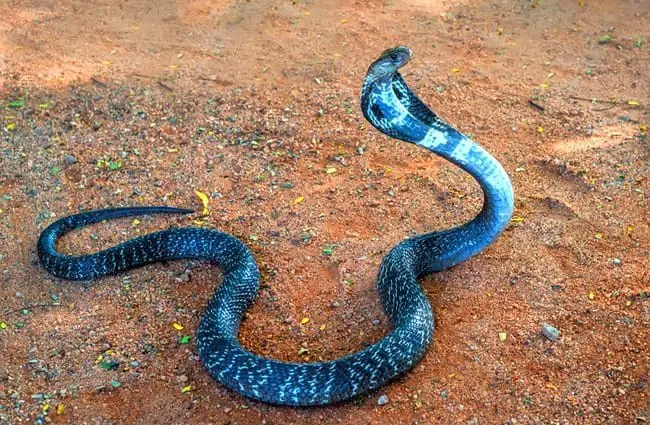
Some King cobras choose to lay their eggs under various natural covers, such as rocks, or in-ground holes. For almost the entire 45 – 80 days of incubation, females would guard their eggs, their bodies vibrating in order to generate heat.
It is only just before the eggs hatch that the female King Cobra is to leave the nest.
King Cobra Hatchlings
The average size of a King Cobra hatchling is about 16 to 18 inches in length.
Eggs have unusually large yolks, as part of the yolk turns into a yolk sac that provides the hatchling with about two-week nourishment supply, even though a hatchling is able to take care of itself from the very first day of its life.
Maturity
The peak of maturity for King Cobras is marked at the moment they become between 4 and 6 years old.
How to Breed
For captive King Cobras, breeding typically occurs from early January to late April. During the brood care period, females tend to become unusually aggressive, so keepers must approach them with extra care and caution.
King Cobra mothers-to-be should be provided with spotlights, allowing for a maximum temperature of 90F (32.2C) to be maintained, even though gravid females rarely ever bask. A ladder of branches must be also provided for future mothers to be able to thermo-regulate over a broad range of temperatures as they see fit.
Handling
If you are to handle a King Cobra snake with too much confidence, mind that this can be extremely dangerous. It is a must to use professional safety equipment, such as hooks and tongs. Alternatively, a broom or a mop can be used.
Before ever handing a King Cobra pet, make sure to always have a first aid kit available at your disposal, including relevant tools against snake bites.
Always move slowly and cautiously and slowly when handling a King Cobra snake. Surprising, quick, and/or sharp movements can easily scare or startle the snake, leading to unwanted, sneaky actions, and possible unfortunate accidents in return.
If the King Cobra snake is to recoil into an S-shape attack mode, stop any attempts to handle it immediately. Wait for it to calm down and to start moving slowly before you make another handling attempt. Also, remember that if you are to move slowly and to remain calm, then the chances for the King Cobra snake to remain calm are much better, too.
Always wash your hands thoroughly with water and soap prior to handling the snake, as you do not want to contaminate or to endanger your King Cobra pet with bacteria and dirt.
Wear gloves and protective equipment any time you are handling a King Cobra snake, as no matter how gently you are to treat this mesmerizing creature, there is always a chance, even if a tiny one, for something to go wrong.
Quite similar to humans, King Cobra snakes need some time alone, and that’s especially true during their feeding routines. Do NOT force your snake at any time. Be extra careful when King Cobra is shedding skin, as it tends to be more irritable/aggressive during this period. Do NOT handle a King Cobra snake if it is deep asleep.
The most appropriate time to handle a King Cobra is when he/she is inactive and sluggish.
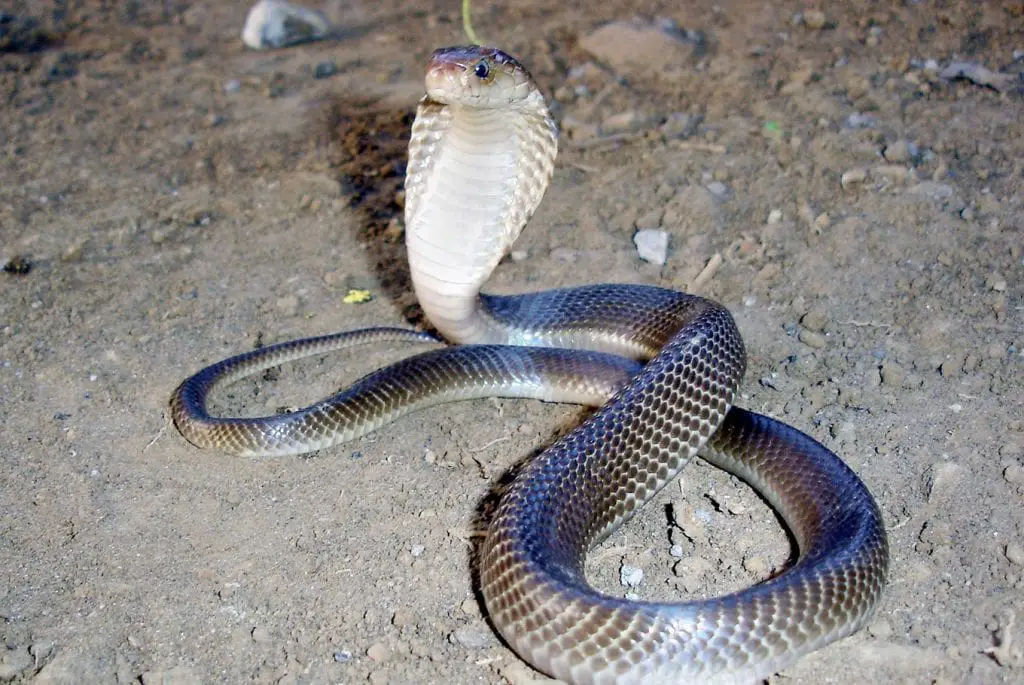
How to Treat and Prevent Possible Health Issues
Bowel issues, as well as obesity, can be prevented and negated if captive King Cobras are to be kept in large cages, and provided the much-needed climbing opportunities. If snakes are kept in too small cages, they often tend to spend most of their time in the hide box, which further gives way to digestive issues due to lack of exercise to arise.
For newly acquired King Cobras, or for King Cobras moved into a new cage, it is critical to minimize any possible stress by letting the animals take their time to survey the surroundings before they settle in without further causing them more tension by bothering them while they are hiding.
Hatchlings are especially susceptible to health damage if the cages are not to be kept meticulously clean.
Weighing a King Cobra snake is crucial in order to monitor its health. In case you have any suspicions about the health and well-being of your King Cobra pet, immediately contact a qualified veterinarian.
With an adult, King Cobra snakes, misting is best to be avoided, except for a day or two before shedding but even then, only mist very, very sparingly. Misting too frequently can lead to respiratory infections.
Hardwood mulch is to prevent the snake from getting in constant contact with the wet substrate, as this can easily lead to skin issues.
Humidity rates should be maintained on the high side, with 70% or higher humidity rates helping to avoid eye cap retention problems and dry sheds.
Possible Dangers to Humans
The venom of King Cobra venom is majorly composed of proteins and polypeptides. It is produced in specialized salivary glands, located behind the eyes.
Venom is forced into the wound through the King Cobra’s fangs.
The venom of King Cobra is less toxic than that of other venomous snakes, such as the Indian Cobra. However, King Cobra snakes can inject more venom than any other snakes, with the gaboon viper being the major exception on that note.
A King Cobra can deliver enough venom for a full-grown Asian elephant to die in 3 hours.
The venom of King Cobras attacks the nervous system of the victims, quickly inducing vertigo, blurred vision, severe pain, paralysis, and drowsiness. In the following minutes, cardiovascular collapse is to lead victims into a coma, with death following soon afterward because of respiratory failure.
Even though the venom of King Cobras is a neurotoxin that is fully capable of killing a human, with mortality rates reaching as high as 75%, it is crucial to note that most bites only involve nonfatal amounts of venom, and fatalities can be minimized provided a medical team is contacted asap after a bite attack.
It is not impossible for a King Cobra snake to deliver as much as up to 7 milliliters of venom per single bite, though, and this amount is enough to kill a total of 20 people.
Ultimately (and fortunately), King Cobra snakes are very shy in nature, and they avoid humans as much as possible. They do not attack unless provoked or cornered and are not fiercely aggressive as common misconceptions imply.
Availability: Where to Get a King Cobra?
Most US states, as well as various countries across the globe, do not allow for individuals to keep king cobras as pets. However, in some countries and in some states, such as Florida, it is legal to keep a king cobra as a pet, provided you have an annual permit to do so.
Purchasing King Cobras from illegal retailers/breeders, and/or possessing a King Cobra without a legal permit, can end with solid fines, and even imprisonment.
Keeping a King Cobra caught in the wild is illegal in most countries, and it is also extremely dangerous to both the snake’s, as well as the keeper’s health and well-being. Only purchase a King Cobra snake from reputable retailers, so that you and your mesmerizing pet can be granted many years of enjoying a happy, healthy, mutually beneficial relationship together.
Fun Facts
- The heaviest King Cobra specimen was one caught in the wild in Singapore in 1951, weighing 12 kg (26 lb), and measuring at 4.8 m (16 ft). In 1972, an even heavier King Cobra captive specimen, measuring 12.7 kg (28 lb) at 4.4 m (14.4 ft) in length, was kept at New York Zoological Park.
- Lord Shiva, the mighty Hindu deity, is often depicted wearing a cobra necklace.
- Some types of cobras are named after their behavior or appearance, such as the monocled cobra (N. kaothia), known to display a distinct, monocle-like circle located on its very hood, or such as the zebra spitting cobra (N. nigricincta), possessing zebra-like stripes.
- Because of the destruction of forests, as well as because of the ongoing illegal international trade, King Cobra populations have greatly dropped in some areas of its natural range.
- In most snake species, females are typically larger than the males. However, with King Cobras, male species typically weigh more, and are also longer, than female species.
- Cannibalism is not rare among King Cobras, and especially in severe cases of hunger.
- Some experts are still debating whether King Cobras are diurnal creatures. Even though King Cobras are fully able to hunt during all times of the day, they are rarely seen hunting at night.
- King Cobra males, similar to most male cobra species, are to perform unique, elaborate dances when trying to win a female cobra’s attention over their competitors during the mating season. The one to win these unusual competitions is often the largest male.
- When the eggs are just about to hatch, the mother King Cobra is to quickly abandon her guard duties, quickly leaving the area in search of other prey to avoid eating her hatchlings.
- King cobras are legendary escape artists, which is one more solid proof of their amazing intelligence and intuition.
- Cobra pearls (aka cobra stones) are bones that are supposedly taken from the venom glands, then highly polished, and used to draw venom out of a wound. In reality, the magical powers of cobra pearls to draw out venom are nothing more but a myth, and in fact, it is not even certain if the cobra pearls do even come from a snake or if they are simply fake.
How to Take Care of a King Cobra
1. Mature king cobras, and especially hatchlings, do require constant access to clean, freshwater daily. After feeding, adults often drink enormous quantities of water. If a hatchling is to dehydrate irreversibly, it can die, and the same can happen if the water source is to contain parts of the substrate in it and/or if it is not changed frequently.
2. Make sure to provide suitable water containers that are large enough to contain the size of your King Cobra snake, as for the snake to be able to fully submerge.
3. After being soiled, cages must be cleaned as soon as possible. Doing so will limit any chances of contamination, as to keep the King Cobra in perfect health.
Adult King Cobra snake produce much liquid with their feces, which means their enclosure is easily susceptible to contamination. Hygiene must be kept as high as feasible at all times.
4. Without proper training, King cobras can be extremely dangerous to be kept in captivity. It is a must to respect the reptile’s personal space and to get well-acquainted with its needs, demands, characteristics, and temper, prior to attempting to keep one as a pet.
5. Lighting, temperature, and humidity rates must be properly maintained.
FAQ Section
How Fast is a King Cobra Snake?
King Cobra is commonly regarded as the fastest snake in the world, capable of moving at an amazing speed of 19 kmh (12 mph), or at 17.6 feet (5.4 meters) per second. King Cobra is the second-longest venomous snake on Planet Earth. It is also the longest venomous snake in Africa.
Can a King Cobra Kill You?
The venom of King Cobra is a neurotoxin, capable of killing one elephant, or 20 people, with a single full injection. However, King Cobras are rather shy, they tend to avoid people, and their venom is not the most potent out there.
What Are King Cobra’s Natural Predators?
Mongooses can typically hunt and kill King Cobra snakes. Sometimes, a King Cobra snake can be preyed by large birds. Currently, humans are the greatest threat to king cobras, since illegal poachers hunt King Cobras to trade with their valuable body parts, and some kill them simply because of being afraid of a possible snake attack, despite the King Cobra’s unaggressive behavior towards humans.
Are King Cobras Smart?
King Cobras are believed to possess a rather uncanny intelligence, showcasing alertness and awareness that extends way beyond what most other snakes showcase. When kept in captivity, a King Cobra can recognize its caregiver, and distinguish him/her from strangers. King Cobra snake is said to be one of the fastest learners when compared to most of the other types of snakes out there.
Can a Human Survive a King Cobra Bite?
No snake, including King Cobra snake, has a 100% mortality rate caused after a bite attack. However, a dry bite is typically much easier to recover from. One could hardly survive a King Cobra bite without seeking professional treatment from a qualified physician.
Are King Cobras Aggressive?
King Cobras would usually attempt to escape rather than to attack, whenever confronted. They are not naturally aggressive towards humans, and only show signs of aggression if provoked continuously and/or in the wrong moment, such as during feeding, shedding, or eggs incubation.
Can King Cobras Swim?
Yes, King Cobras can swim, and this is exactly why they are typically found near water sources. Apart from possessing excellent swimming skills, a King Cobra is also master of slithering on land, as well as climbing trees.
Is the King Cobra a True Cobra?
Despite being named the king of cobras, a King Cobra snake does actually not belong to the genus of true cobras, the Naja genus. Out of more than 270 different species of cobras, only 31 belong to the Naja genus.
Why Cobra is Called King?
King Cobra is not called King without a reason. It is the only snake species known to eat its own venomous species, without the ingested venom having any negative effect on the King Cobra’s body. The scientific name for King Cobra is Ophiophagus hanna and translated from Latin, the very word Ophiophagus means “snake eater.”
Do King Cobras Eat other King Cobras?
A King Cobra is the King of all cobras not merely because of its impressive size but also because of its deadliness. King Cobras do eat other snakes, including deadly ones, such as other cobras and kraits. Eating other King Cobras is also possible, as cannibalism is not an exception among King Cobra snakes.
Are King Cobras Endangered and Why is that so?
Yes, the world’s largest venomous snakes, King cobras, were officially listed as “vulnerable” because of over-exploiting for medicinal purposes, as well as because of loss of habitat. The major reason for King Cobras entering the Red list of endangered species is none other but the sustained loss of habitat, driven by humans’ greed, negligence, and corrupt over-consumerism practices.

